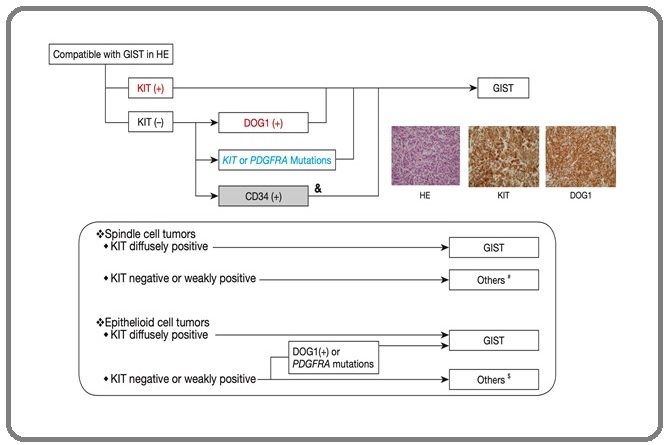Gastrointestinal Stromal Tumor Coexistence with Multiple Myeloma: A Case Report
Download
Abstract
Objectives: Gastrointestinal stromal tumor (GIST) is a tumor that is rarely found and is characterized by positive KIT (CD117) and DOG1 results. Multiple myeloma (MM) is characterized by malignant proliferation of uncontrolled plasma cells in the bone marrow which produces abnormal proteins in plasma or urine. The coexistence of GIST and other solid cancers in the gastrointestinal tract and urinary tract have been widely reported, but GIST coexistence with hematologic malignancies is a scarce case.
Methods: Case Report.
Results: Immunochemistry plays an important role in determining the diagnosis and treatment of GIST. Concomitant therapy between GIST dan MM gives good results.
Conclusion: The management of both diagnoses is carried out simultaneously while considering the possibility of various side effects that arise. For GIST, given target therapy with Imatinib mesylate which is the selected target therapy, while for MM given conventional therapeutic regimens according to the patient's age and ability. In the condition of coexistence of the two types of disease, the management of the disease that most influence the quality of life with a worse prognosis, is made as the main target of initial treatment.
Introduction
Case Presentation
A man, 72 years old with complaints of weakness accompanied by low back pain since 3 months ago. Physical examination revealed pale palpebral conjunctiva and a lump in the abdomen. Abdomen CT-Scan showed solid malignant in the upper left abdominal cavity and immunohistochemical results showed CD117 (+) and DOG1 (+) in all tumor cells. Laboratory results showed hemoglobin 8.7 g/dL, urea 58 mg/dL, creatinine 1.8 mg/dL, albumin 2.3 g/dL, globulin 12.8 g/dL, uric acid 11.7 gr/dL, and calcium 13.1 mg/dL with serum protein electrophoresis which showed decreased albumin fractions α1, α2, β1, and β2; an increased γ fraction with an inverse albumin/globulin ratio is appropriate for monoclonal gammopathy. Bone survey with multiple teardrops lytic lesions on the calvary bones, cervical vertebrae, all thoracic vertebrae, lumbar vertebrae, pelvic bones, part of the proximal sternum and humerus bilaterally.
The results of the bone marrow aspiration examination showed 25% plasma cells.
Discussion
Gastrointestinal stromal tumors (GIST) are a subgroup of malignant mesenchymal tumors that arise from the interstitial Cajal cells of the gastrointestinal tract. Based on the Asian GIST management consensus, the GIST diagnosis algorithm is based on positive immunostaining for KIT (CD117) and DOG1 [1]. The standard treatment for patients with GIST is the administration of tyrosine kinase inhibitor (Imatinib) given at a dose of 300 mg q.d. based on the weight of the patient accompanied by anemic conditions that require close monitoring, associated with gastrointestinal side effects and myelosuppression. Treatment response was evaluated every 3 months in the first 2 years and if improvement was found it could be done every 6 months [2] (Figure 1).
Figure 1. Algorithm for Diagnosis of GIST from Immunohistochemical Staining [1].

This patient, apart from being diagnosed with GIST as a form of solid malignancy, was also suffering from active multiple myeloma (MM) blood disease which is characterized by an organ disorder known as mnemonic CRAB consisting of hypercalcemia, impaired renal function, anemia, and bone lytic disease. These patients were classified in the frail group who had a higher likelihood of experiencing treatment side effects, a greater risk of treatment discontinuation, and lower overall survival and progression-free survival [3]. Considering various clinical considerations (ECOG performance status, frailty status, and socioeconomic), it was decided to give induction therapy with an MP regimen consisting of Melphalan 0.25 mg/kg body weight given orally (days 1-4) and Prednisone 100 mg given orally (days 1-4); 6-week intervals until the plateau phase is reached [4]. In this patient there is a rare condition, due to the presence of coexistence of solid malignancy (GIST) and hematological malignancy (MM). Ponti et al. [5] reported several cases of GIST together with other solid malignancies, but GIST together with hematologic malignancies in the form of MM have not been reported. Therapy must be carried out simultaneously although the priority is MM because it is predicted to have a worse prognosis, whereas, for GIST conditions, tyrosine kinase inhibitors are given according to the GIST treatment guidelines.
References
- Asian consensus guidelines for gastrointestinal stromal tumor: what is the same and what is different from global guidelines Nishida T. Translational Gastroenterology and Hepatology.2018;3. CrossRef
- Gastrointestinal stromal tumours: ESMO-EURACAN Clinical Practice Guidelines for diagnosis, treatment and follow-up Casali PG , Abecassis N, Aro HT , Bauer S, Biagini R, Bielack S, Bonvalot S, et al . Annals of Oncology: Official Journal of the European Society for Medical Oncology.2018;29(Suppl 4). CrossRef
- Multiple myeloma: 2018 update on diagnosis, risk-stratification, and management Rajkumar SV . American Journal of Hematology.2018;93(8). CrossRef
- Approach to the Older Adult With Multiple Myeloma Mina R, Bringhen S, Wildes TM , Zweegman S, Rosko AE . American Society of Clinical Oncology Educational Book. American Society of Clinical Oncology. Annual Meeting.2019;39. CrossRef
- Gastrointestinal stromal tumor and other primary metachronous or synchronous neoplasms as a suspicion criterion for syndromic setting Ponti G, Luppi G, Martorana D, Rossi G, Losi L, Bertolini F, Sartori G, et al . Oncology Reports.2010;23(2).
License

This work is licensed under a Creative Commons Attribution-NonCommercial 4.0 International License.
Copyright
© Asian Pacific Journal of Cancer Care , 2023
Author Details
How to Cite
- Abstract viewed - 0 times
- PDF (FULL TEXT) downloaded - 0 times
- XML downloaded - 0 times